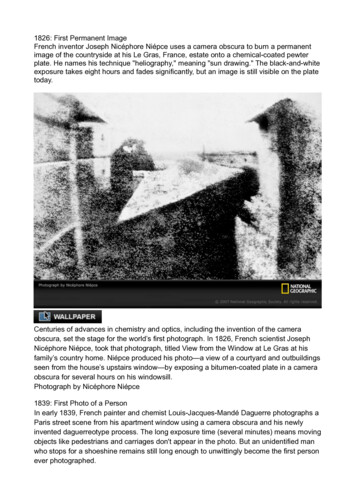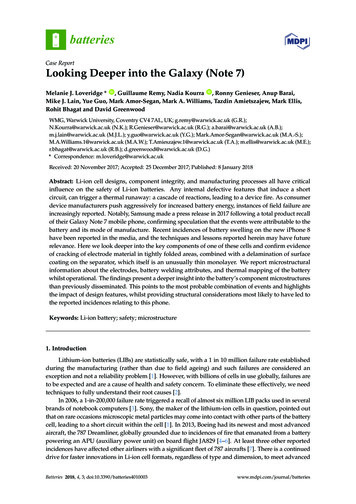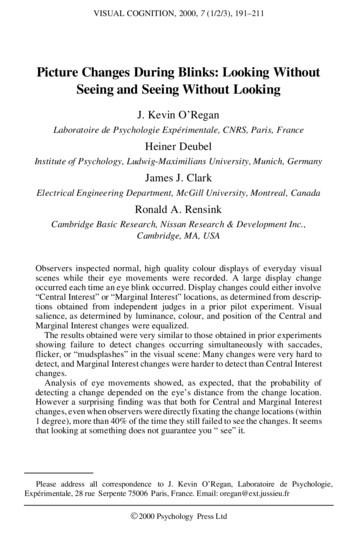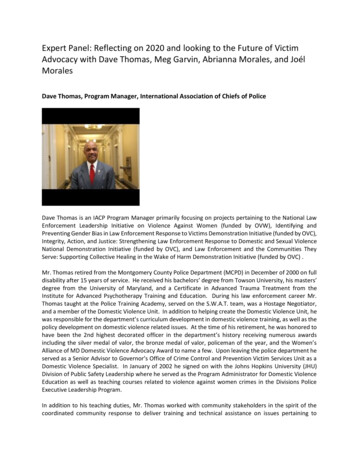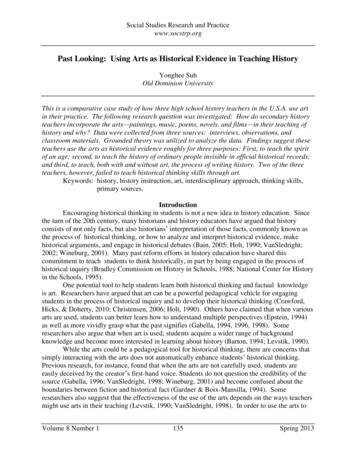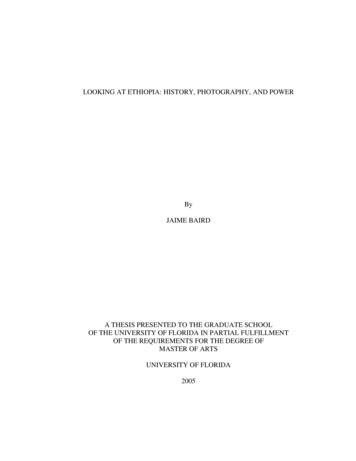
Transcription
LOOKING AT ETHIOPIA: HISTORY, PHOTOGRAPHY, AND POWERByJAIME BAIRDA THESIS PRESENTED TO THE GRADUATE SCHOOLOF THE UNIVERSITY OF FLORIDA IN PARTIAL FULFILLMENTOF THE REQUIREMENTS FOR THE DEGREE OFMASTER OF ARTSUNIVERSITY OF FLORIDA2005
Copyright 2005byJaime Baird
This thesis is dedicated to Brian, Hayes, and Marley.
ACKNOWLEDGMENTSThe study would not have been possible without the generous assistance of a greatmany people. Firstly, I would like to thank my committee: Robin Poynor and VickiRovine provided guidance and crucial insight throughout every stage of this project, andEric Segal was always available to answer my questions and give valuable advice.Additionally, all three offered moral support and encouragement during the arduous finalstages of the writing process. Dr. Rebecca Nagy, Director of the Harn Museum of Art,also provided much crucial assistance. Her vibrant enthusiasm for Ethiopian culture wasthe impetus for my own interests in this topic and had it not been for her encouragement,I may never have realized how rich Ethiopian culture truly is. I would also like to thankseveral other professors, who all contributed in one way or another to my thinking on thisproject. In the art school, Dr. Barbara Barletta, Dr. Alex Alberro, and Dr. Melissa Hyde,all deserve many thanks. I would also like to thank Dr. Abdoulaye Kane in anthropology,Dr. Fiona Mclaughlin in linguistics and African studies, Dr. Joan Frosch in theater anddance, and Dr. Akintunde Akinyemi in African languages.I am also very grateful to several individuals who assisted me in a number of waysduring the research and writing process. While my ideas were still in a very formativestage, Dr. Al Roberts offered advice on how to direct my research, and as my projectneared completion, Dr. Peri Klemm provided valuable insight and encouragement, andDr. Jon Abbink amiably replied to all of my numerous queries about Suri culture. Iwould also like to thank Tom Southall whose keen enthusiasm for my topic was a greativ
inspiration. Dan Reboussin and John Nemmers deserve many thanks for their support andeagerness to share their hard-earned research and ideas with me. Ras Adam Simeon, JahJim Marshall, and BenGee also deserve a great deal of thanks for sharing not onlyinformation but also a significant aspect of their lives with me for this project.I also wish to thank my fellow students in the art and art history, and Africanstudies programs at the University of Florida, without whom I would never have had thecourage to undertake this study. In particular, I wish to thank Mariola Alvarez, JeremyCuller, Wood D. Weber, Kathy Huala, Izabela Riano, Lauren Turner, Natalie Haddad,Joann Ihas, Jody Berman, Ade Ofunniyin, Ann Baird, and Tim Nevin. Most of all Iwould like to express my enormous gratitude to Nicholas Frech, who provided assistance,friendship, and undying support during my entire time at the University of Florida.Last, but certainly not least, I wish to thank Brian Henderson and our two dogsHayes and Marley, whose love and support kept me alive and sane.v
TABLE OF CONTENTSPageACKNOWLEDGMENTS . ivLIST OF FIGURES . viiABSTRACT. xiiCHAPTER1INTRODUCTION: SCOPE AND CONTENT .1Ethiopia: An Overview .6Ethiopia and the History of African Photography .11Organization and Goals .172MAPPING ETHIOPIA’S HISTORY: LEGENDS OF THE NILE AND THEÆTHIOPIAN OCEAN .25Early Visions of Africa.26Æthiopia, Abyssinia and the Quest for Prester John .31The “Habit” of an Ethiopian .403PHOTOGRAPHING ETHIOPIA: THE SAFARI AND THE PILGRIMAGE.63Gazing at Ethiopia .64Touring Ethiopian Bodies.70Gazing Back.75Authenticity as Spectacle and the Politics of Display .81Beckwith and Fisher’s Ethiopia in Context .884VISIONS OF POWER: THE IMAGE OF EMPEROR HAILE SELASSIE I.105The Image of Selassie in the Western Media .106Selassie as the CAL SKETCH .153vi
LIST OF FIGURESFigurepage1.1Photograph of a Suri man by Carol Beckwith and Angela Fisher .201.2Formal coronation portrait of Haile Selassie.211.3Linguistic map of Ethiopia.221.4Map of Ethiopia showing regional boundaries of the nine Ethiopian States .221.5Spirit of Sisterhood, by Aida Muluneh.231.6Lij Iyasu, his father Ras Mickael and Ras Hapte Ghiorgis. Attributed to BedrosBoyadjian. Private Collection (Pankhurst and Gérard, 1998: 127).242.1Map of the World according to Ptolemy’s second projection, 1482.492.2Reconstruction of Ptolemy’s oikoumenē.492.3Libyē (Africa) according to Ptolemy .502.4Reconstruction of Libyē (Africa), following Ptolemy.502.5“T-O” map.512.6Copy of a map by al-Idrisi.512.7Sebastian Münster’s Map of Africa .522.8National Geographic map of Ethiopia printed in 1931.522.9Africa According to y Newest and most Exact Observations created by HermanMoll, London, 1714.532.10 Detail of figure 2.9 .532.11 Africa Ex Magna Orbis Terre created by Gerard Mercator (the younger), 1595 .542.12 Detail of figure 2.11 .542.13 Detail of figure 2.11 .55vii
2.14 Detail of figure 2.11 .552.15 Africae Tabula Nova, created by Abraham Ortelius, Antwerp, 1570 .562.16 Presbiteri Johannis Abissinorium Imperii Descripto (A representation of theempire of Prester John, or, of the Abyssinians), created by Abraham Ortelius,Antwerp, 1573.562.17 Habessinia or Abassia, Presbyteri Johannis Regio. (“Habessinia” or “Abassia,”the Land of Prester John.) Created by Hiob Ludolf, 1683 .572.18 Detail of figure 2.17. .572.19 Detail of Africæ Nova Descriptio (Africa Newly Described), created by WillemBlaeu, 1630.582.20 Detail of Africæ, map of Africa created by John Speed, London, 1626 .582.21 Guinea, created by Willem Blau, Amsterdam, 1635 .592.22 Detail of figure 2.21. .592.23 Æthiopia Inferior vel Exterior (“Lower or Outer” Æthiopia), made by JanJansson after an earlier map by Jan Blau (1642).602.24 Detail of figure 2.23. .602.25 Paskaerte Van West Indien de Vaste Kusten en de Eylanden, created by PieterGoos, nd., probably late 1660s. .612.26 Detail of figure 2.25. .612.27 Illustration from The Entertaining Traveler; or, the Whole World in Miniature,by John Fransham and printed by Henry Holmes, London, 1767.622.28 Illustration from History of All Nations, printed by David Paterson, Edinburgh,1777.622.29 Image of the Emperor of Abyssinia from Allain Manesson Mallet’s Descriptionde L’Univers, 1685.623.1Ethiopian Orthodox Priest, at a rock-hewn church in Lalibela. Photography byCarol Beckwith and Angela Fisher .933.2Suri men painting their bodies in preparation for Donga. Photograph by CarolBeckwith and Angela Fisher .943.3Suri body painting. Photograph by Carol Beckwith and Angela Fisher .95viii
3.4Suri body painting. Photograph by Carol Beckwith and Angela Fisher .953.5Suri woman wearing a lip-plate. Photograph by Carol Beckwith and AngelaFisher.963.6Priest standing at the entrance of the maqdas (“holy of holies”) of the church ofUra Kidane Mehret on Lake Tana. Photograph by Carol Beckwith and AngelaFisher.973.7Konso man. Photograph by Carol Beckwith and Angela Fisher.983.8Konso man and Konso architecture. Photography by Carol Beckwith and AngelaFisher.993.9Hamar women. Photography by Carol Beckwith and Angela Fisher .1003.10 Early 20th century postcard of Algerian women.1013.11 Young Konso woman. Photograph by Carol Beckwith and Angela Fisher.1023.12 Amhara woman and Orthodox priest. Photograph by Carol Beckwith andAngela Fisher .1033.13 Maasai girl undergoing painful excision. Photograph by Carol Beckwith andAngela Fisher .1043.14 Maasai girl undergoing excision. Photography by Carol Beckwith and AngelaFisher.1044.1Photograph of Haile Selassie’s coronation, front cover of Le Miroir du Monde,37 (November 15, 1930). .1184.2Haile Selassie’s coronation, front cover of L’Illustration.1194.3Haile Selassie’s coronation, front cover of The Illustrated London News.1204.4Haile Selassie’s coronation. Photograph by George W. Moore. From a featurearticle in National Geographic Magazine 59 no.6 (June 1931).1214.5Emperor Haile Selassie I on the cover of Time Magazine .1214.6Britain’s Duke of Gloucester arriving in Addis Ababa for the coronationceremony .1224.7Autographed portrait of Haile Selassie .1224.8Benito Mussolini facing a coronation portrait of Haile Selassie, from the NewYork Times.123ix
4.9Haile Selassie with his foot on an unexploded Italian gas bomb. Cover of TheIllustrated London News. .1234.10 Haile Selassie and soldiers on the cover of The Illustrated London News. .1244.11 Haile Selassie on the cover of The Illustrated London News.1244.12 Haile Selassie on the cover of Newsweek.1254.13 Haile Selassie on the cover of Time Magazine. .1254.14 Haile Selassie on front cover of Der Spiegel. .1264.15 Haile Selassie on the front cover of Epoca. .1264.16 Starving Ethiopian child and mother on the cover of Time Magazine.1274.17 Starving Ethiopian woman. Photograph by Anthony Suau. Rolling Stone.1274.18 Rastafari wearing a necklace with a red, yellow and green picture of Africa anda t-shirt bearing an image of Ras Tafari .1284.19 Dreadlocked Rastafari wearing a t-shirt bearing Haile Selassie’s image.1294.20 Tote bag with coronation image of Haile Selasse .1294.21 “Jah is my co-pilot” bumper sticker .1304.22 Haile Selassie I medal from his Silver Jubilee Fair in 1955 .1304.23 Haile Selassie cigar band.1304.24 Haile Selassie and his wife, Empress Menen on the front cover of Jahug 5 Alphaand Omega .1314.25 Bob Marley and Haile Selassie on the cover of the re-released version ofSelassie is the Chapel. (Bob Marley and Wailers, JAD Records, 1998) .1314.26 Formal coronation portrait of Haile Selassie. Photograph by Haïgaz Boyadjian,1930.1324.27 Formal portrait of Haile Selassie. Probably taken by Haïgaz Boyadjian.1324.28 Formal coronation portrait of Haile Selassie and his wife, Empress Menen.Probably taken by Haïgaz Boyadjian. .1334.29 Rastafari adaptation of one of Haïgaz Boyadjian’s formal coronation portraits ofHaile Selassie .133x
4.30 Haile Selassie and other African leaders at the Heads of State Conference,Kampala, Uganda, 1967. Photograph by Marion Kaplan .1344.31 Slightly different image of Haile Selassie and other African leaders at the Headsof State Conference, Kampala, Uganda, 1967. .1344.32 Young girl performing the sign of the heart.1354.33 BenGee (right) with Joseph Hill (left) of the Jamaican reggae group Culture.135xi
Abstract of Thesis Presented to the Graduate Schoolof the University of Florida in Partial Fulfillment of theRequirements for the Degree of Master of ArtsLOOKING AT ETHIOPIA: HISTORY, PHOTOGRAPHY, AND POWERByJaime BairdAugust 2005Chair: Robin PoynorCochair: Victoria RovineMajor Department: Art and Art HistoryVisual imagery has played an important role in the formation of Westernperceptions of Ethiopia. This thesis addresses historical and contemporary visualrepresentations in maps, books, and photographs in order to explore how looking atimagery defines not only what is known about Ethiopia and Ethiopian people, but alsohow that knowledge operates in specific cultural contexts. By focusing on how theseimages are used and understood in Western culture, it will be demonstrated that meaningis generated in both individual and social situations.This study is organized into five chapters, including an introduction, and a briefconclusion. Chapters 2 through 4 each deal with a specific methodological approach forlooking at visual imagery. As an introduction for modes of looking, my analysis inchapter 2 explores how visual representations can be read as texts. In chapter 3, I furtherthis approach to include the subjectivities that are embedded in the imagery, and thedifferent power structures that encode them with meaning. Chapter 4 utilizes axii
combination of looking techniques as presented in the previous two chapters, whilesimultaneously projecting the process of looking back onto the image—in other words;the image as a “thing” that develops its own history or histories in different viewingcontexts.Visual representations are always viewed through a filter of cascading contexts, asystem of interlocking looks or gazes that converge and diverge at different points andlocations in history. Numerous contexts are embedded within the representation itself,and, to some degree, these embedded contexts are stable, and can be read. At the sametime, other and equally significant contexts are created by the trajectory of therepresentation as it moves around acquiring meaning in different and often remarkablysingularized ways. By addressing the history of Ethiopia as a history of the wayEthiopian people have been represented, I also hope to show that these two trajectories ofthe photographic image—the photographed subject and the photograph as subject—arecontingent and intertwined.Ethiopia has been exceptionally well-represented in the Western popular media,particularly during the 20th century; however, Ethiopia is virtually absent from academicstudies of African visual culture. This thesis is intended, therefore, to fill a gap not onlyin the history of photographic practice and Africa, but also to serve as a contribution toEthiopian and African visual studies in general.xiii
CHAPTER 1INTRODUCTION: SCOPE AND CONTENTI want a History of Looking (Barthes, 1981: 12)Drawn against an austere backdrop of dry greenish haze, the man’s face in figure1.1 stands alone, isolated, it would seem, not only from the rest of his body, but also fromthe surrounding material world. Transformed into an objet d’art by the magic of thecamera, the man in the photograph becomes an icon of timeless beauty—a symphony ofcolor and form wrought from the palate of real life. Figure 1.2, however, presents a verydifferent picture. The latter example shows Emperor Haile Selassie I, who ruled Ethiopiaas absolute sovereign from 1930 until he was deposed by the Marxist Derg regime in1974. Depicted in ornate coronation regalia and wearing an elaborate crown, HaileSelassie is presented as the classic embodiment of steadfast imperial power. These twoimages are paired here as an abridged representation of the two dominant discursivespheres Ethiopia operates within—thematically and historically.As portraits, both photographs are a very particular kind of visual representation.Portraiture is always given special mention in the history of photography, usually becauseof the power of presence it grants to unique human life. Walter Benjamin, for example,writes that “in the fleeting expression of the human face, the aura beckons for the lasttime.”1 This, Benjamin realizes, is “what gives them their melancholy and incomparablebeauty.”Walter Benjamin, “The Work of Art in the Age of its Mechanical Reproducibility,” in Selected Writings,vol. 3. Ed. Howard Eiland and Michael W. Jennings (Cambridge: Harvard University Press, 2002): 10811
2No matter how many times they are reproduced, photographs of human subjectscarry a trace of the subject’s “aura” or individual biography. Additionally, photographs,like all visual representations, are always viewed through a filter of cascading contexts, asystem of interlocking “looks” or “gazes” that converge and diverge at different pointsand locations in history. Numerous contexts are embedded within the representationitself, and, to some degree, these embedded contexts are stable, and can be read. At thesame time, other, and equally significant contexts are created by the trajectory of therepresentation as it “moves around” acquiring meaning in different, and often remarkablysingularized ways.2 This study focuses on representations of Ethiopia and Ethiopianpeople. By addressing the history of Ethiopia as a history of the way Ethiopian peoplehave been represented, I hope to show that these two trajectories of the photographicimage—the photographed subject and the photograph as subject—are contingent andintertwined.The photograph in figure 1.1 was taken by Carol Beckwith and Angela Fisher andit appears in Faces of Africa, the newest edition in their line of popular “coffee-tablebooks” about culture and life in Africa. In situ the caption reads:Surma, Ethiopia: Barchini, with his chiseled features and long elegant body, wasone of the handsomest and most seductive men we met in Surmaland. Afterpainting his body with beautiful chalk designs on the banks of the Dama River, hewould turn around and gaze at us intensely, seeking our approval. We were sodisarmed by his powerful expression that sometimes we would forget to press ourcamera shutters.3The edited volume, The Social Life of Things is perhaps the best collection of essays that address the waythings, in this case commodities, move around and acquire meaning in different contexts. ArjunAppadurai, ed., The Social Life of Things: Commodities in Cultural Perspective (Cambridge: CambridgeUniversity Press, 1986). Appadurai’s introductory chapter and Igor Kopytoff’s contribution wereparticularly useful for the present study.2Carol Beckwith and Angela Fisher, Faces of Africa (Washington D.C.: National Geographic Society,2004): 86.3
3Like many other “ethnic” groups in Africa that have become victims of their owniconicity—the Nuba for Leni Riefenstahl, the Himba in Namibia, the Maasai in general—in Beckwith and Fisher’s work, the “Surma” have become the perennial sexy savages,ever-ready emblems of natural beauty and virulent receptacles of “authentic” primalyearnings and desire.4 This caption is far more explicitly exoticizing than the stylizedexplanatory texts tacked on to most of Beckwith and Fisher’s more “documentary”flavored works, yet the image of Ethiopia it promotes is not exceptional in their oeuvre.Early on in its history, photography was adopted as a tool for exercising verydifferent kinds of power. For over 150 years now it has been used variously to exploit,flatter, categorize, remember, identify, measure, study, and control real people with reallives in an array of localized and international contexts. Some of the most probingdiscussions of photographic history are, in fact, rigorous social critiques, addressing howthe camera and its product became not only an avenue towards voyeuristic revelry, butalso a surveillance apparatus, and a means to generate essentializing racial and classbased categories. Photography also has a long history as art, as well as a reputation fordisrupting the very systems by which artworks have traditionally acquired cultural,economic, and political value.5 In his erudite study “The Body and the Archive,” for4For a critique of Leni Riefenstahl’s photographs of the Nuba of Sudan, see Susan Sontag, “FascinatingFascism,” in Under the Sign of Saturn (London: Vintage, 1996): 71-105; for an excellent study ofrepresentations of the Himba, see Michael Bollig and Heike Heinemann, “Nomadic Savages, Ochre Peopleand Heroic Herders: Visual Presentations of the Himba of Namibia’s Kaokaoland,” Visual Anthropology 15(2002): 267-312. In her work on the Samburu, Sydney Kasfir discusses the iconic status of the Maasai inthe Western world. See “Slam-Dunking and the Last Noble Savage,” Visual Anthropology 15 (2002): 369385 and “Samburu Souvenirs: Representations of a Land in Amber,” in Ruth Phillips and ChristopherSteiner, eds., Unpacking Culture: Art and Commodity in Postcolonial Worlds (Berkeley: University ofCalifornia Press, 1999): 67-83.See Rosalind Krauss, “Photography’s Discursive Spaces: Landscape/View,” Art Journal 42, no. 4(Winter 1982): 311-319; Walter Benjamin, “A Short History of Photography,” in Classic Essays onPhotography, ed. Alan Trachtenberg (Leete’s Island Books, 1980): 199-218; Walter Benjamin, “The Workof Art in the Age of its Mechanical Reproducibility,” in Selected Writings, vol. 3, ed. Howard Eiland and5
4instance, Alan Sekula reveals photography’s “paradoxical status,” as a “doublesystem of representation capable of functioning both honorifically and repressively”simultaneously.6 Control over how these concatenated powers are exerted and yielded,and the processes by which they both limit and provoke reality, he then argues, shouldnever be underestimated.Carol Beckwith and Angela Fisher’s photographs of Ethiopia exemplify howdangerous photography can be when its power is wielded with little to no regard for themessage it communicates to both Western and non-Western audiences about life andculture in Africa. Their work is certainly honorific: indeed, their books usually beginwith a proclamation about how grateful they are to have been able to capture so manybeautiful images, followed by a statement about how they want to “give something back”to Africa by “celebrating” its unique and, above all, “ancient” cultures. Their work isalso repressive—they omit anything deemed inauthentic, obscuring the complexities ofmodern life in Africa in order to supply the world market with the prototypical image ofthe non-Western. In his review of their previous major publication, African Ceremonies,Anthony Appiah eloquently notes:Certainly you would never guess from “African Ceremonies” that by the year 2020half the population of Africa will live in cities. The focus of salvaging adisappearing past means that there are no state openings of parliament, noweddings in white in modern Christian churches, no graduations from thecontinent’s universities.7Michael W. Jennings (Cambridge: Harvard University Press, 2002): 101-133; Waltar Benjamin, “A ShortHistory of Photography,” in Classic Essays on Photography, ed. Alan Trachtenberg (New Haven: Leete’sIsland Books, 1980) 199-216; and Allan Sekula, “The Body and the Archive,” October 39 (Winter 1986):3-64.6Sekula, Ibid, 6.7K. Anthony Appiah. “The Rite Stuff,” New York Times Book Review (December 5, 1999): 13.
5By assuming that African traditions are remnants of the past rather than dynamicprocesses subject to the flow of time and history, Beckwith and Fisher reinforce thenotion that modernity is restricted to the Western domain.Perhaps this is the appropriate juncture to mention that most of the photographs andother visual examples I re-present in this study are images of Ethiopia and Ethiopianscreated primarily by Westerners for Western audiences. Even the ones that wereoriginally made in and for Ethiopia (discussed below and in the last chapter) areaddressed as they operate in a predominantly Western context. As several recent studiesof African art and visual culture have shown, Western and African representationalsystems are not mutually independent. For instance, in her work on the Samburu ofKenya, Sydney Kasfir brings to light the ambiguities and tensions that exist betweenSamburu self-representation (through personal adornment, weaponry, and comportment)and representations of Samburu in photography, postcards, the tourist trade, and evenHollywood movies.8 In Christopher Steiner’s numerous explorations of “authenticity”and African art in the global market place, he utilizes Walter Benjamin’s critique ofmechanical reproduction in order to show how seriality produces its own aestheticconstructs, especially as images and objects move from one socio-geographic domain toa
looking at ethiopia: history, photography, and power by jaime baird a thesis presented to the graduate school of the university of florida in partial fulfillment of the requirements fo

